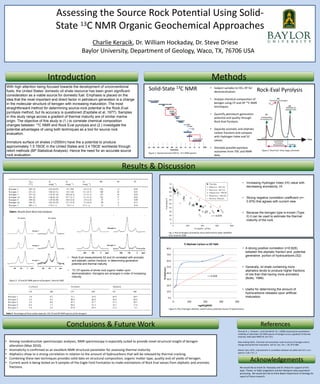
URSA charlie %5bAutosaved%5d 2 (3)
- 1. Assessing the Source Rock Potential Using Solid- State 13C NMR Organic Geochemical Approaches Charlie Keracik, Dr. William Hockaday, Dr. Steve Driese Baylor University, Department of Geology, Waco, TX, 76706 USA Introduction Methods Results & Discussion Conclusions & Future Work References Acknowledgements With high attention being focused towards the development of unconventional fuels, the United States’ domestic oil shale resource has been given significant consideration as a viable source for domestic fuel. Emphasis is placed on the idea that the most important and direct factor in petroleum generation is a change in the molecular structure of kerogen with increasing maturation. The most straightforward method for determining source-rock potential is the Rock-Eval pyrolysis method, but its accuracy is questioned (Espitalie et al, 1977). Samples in this study range across a gradient of thermal maturity are of similar marine origin. The objective of this study is (1.) to correlate chemical composition changes between 13C NMR and Rock Eval pyrolysis and (2.) investigate the potential advantages of using both techniques as a tool for source rock evaluation. Immature surface oil shales (<2500m) have the a potential to produce approximately 1.5 TBOE in the United States and 3.4 TBOE worldwide through retort methods (BP Statistical Analysis). Hence the need for an accurate source rock evaluation. Rock-Eval PyrolysisSolid-State 13C NMR • Increasing Hydrogen Index (HI) value with decreasing aromaticity. HI. • Strong negative correlation coefficient (r=- 0.979) that agrees with current view. • Because the kerogen type is known (Type II) it can be used to estimate the thermal maturity of the rock. • Subject samples to HCL-HF for demineralization • Analyze chemical composition of kerogen using CP and DP 13C NMR techniques. • Quantify petroleum generation potential and quality through Rock-Eval Pyrolysis. • Separate aromatic and aliphatic carbon fractions and compare with Hydrogen Index and S2 values. • Simulate possible pyrolysis outcomes from TOC and NMR data. Table 2. Percentage of three carbon types for 13C CP and DP NMR spectra of the kerogens Table1: Results from Rock-Eval analyses • Rock Eval measurements S2 and HI correlated with aromatic and aliphatic carbon fractions in determining generative potential and thermal maturity. • 13C CP spectra of whole rock organic matter upon demineralization. Kerogens are arranged in order of increasing maturity. r = -0.979 • A strong positive correlation (r=0.828) between the aliphatic fraction and potential generative portion of hydrocarbons.(S2) • Generally, oil shale containing more aliphatics tends to produce higher fractions of oils than that having more aromatics (Botto, 1996). • Useful for determining the amount of hydrocarbons released upon artificial maturation. • Among nondestructive spectroscopic analyses, NMR spectroscopy is especially suited to provide novel structural insight of kerogen alteration (Mao 2010). • Aromaticity is confirmed as an excellent NMR structural parameter for assessing thermal maturity. • Aliphatics show to a strong correlation in relation to the amount of hydrocarbons that will be released by thermal cracking. • Combining these two techniques provides solid data on structural composition, organic matter type, quality and oil yields of kerogen. • Current work is being tested on 9 samples of the Eagle Ford Formation to make estimations of Rock Eval values from aliphatic and aromatic fractions. Fig. 2. Plot of kerogen aromaticity versus Rock-Eval HI index. Modified from Smernik 2006 Figure 3: CP and DP NMR spectra of kerogens. Smernik 2006 Smernik R. J., Schwark L. and Schmidt M. W. I. (2006) Assessing the quantitative reliability of solid-state 13C NMR spectra of kerogen across a gradient of thermal maturity. Solid state NMR 29, 312–321. Mao Jindong 2010., Chemical and nanometer-scale structure of kerogen and its change during thermal maturation. Soil Sci. Soc. Am. J. 64, 873–884. Maciel, Gary 1979., improvement in correlation between oil yields and 13 C n.m.r spectra. Fuel v 52 I, 2 We would like to thank Dr, Hockaday and Dr. Driese for support of this topic. Thanks to Todd Longbottom and Ken Boling for data acquisition/ processing. We would also like to thank Baylor Department of Geology for suport of future research. Figure 4: Plot of kerogen aliphatic content versus potential release of hydrocarbons. Figure 1: Typical chemical shift for 13 C NMR spectra Figure 2: Rock Eval three stage schematic.
